Athens Walking Tours : Classics
Introduction
Athens Walking Tours : Athens is one of the oldest European cities, widely regarded as the birthplace of Western Civilization. Its history begins in the Neolithic period between 4th and 3rd millennium BC. The first settlement on the site of Athens was situated on the rock of Acropolis which means “high city” in Greek. According to the Greek mythology, the name “Athens” emerged from a competition between the goddess of wisdom, Athena, and the god of sea, Poseidon. Both wanted to become patron of the city. To please the locals, Poseidon used his power to create a massive, foamy stream of water. Initially, the people were excited with the generous gift, but then realized that it was actually seawater, unfit for human consumption. Athena, in turn, gifted the city with an olive tree. A highly practical choice, it gave the people food, fuel, and wood to build homes. So, ultimately, they decided in favor of Athena to be their patron and named the city in her honor.
The period of 5th and 4th century BC marked the zenith of Athens as a European center of literature, philosophy and arts. Some of the most significant cultural and intellectual figures in western civilization of that time lived in Athens. Among them dramatists Aeschylus, Aristophanes, Euripides and Sophocles, philosophers Aristotle, Plato and Socrates, historians Herodotus, Thucydides and Xenophon, poet Simonides, and sculptor Phidias. The city passed through periods of decline after the fall of the Roman Empire. By the early 19th century, its population had fallen below 5,000. The period of rebirth started in 1832 under King Otto who re-established Athens as the capital of Greece. The city enjoyed significant comeback after the World War II seeing migrants from villages and islands coming in search of work. Greece’s entry into the European Union boosted the growth further.
On this self-guided walk, we are going to explore Athens as the cradle of Western Civilization and discover some of its many archaeological gems, plus visit several popular shopping and recreation areas.
Parthenon
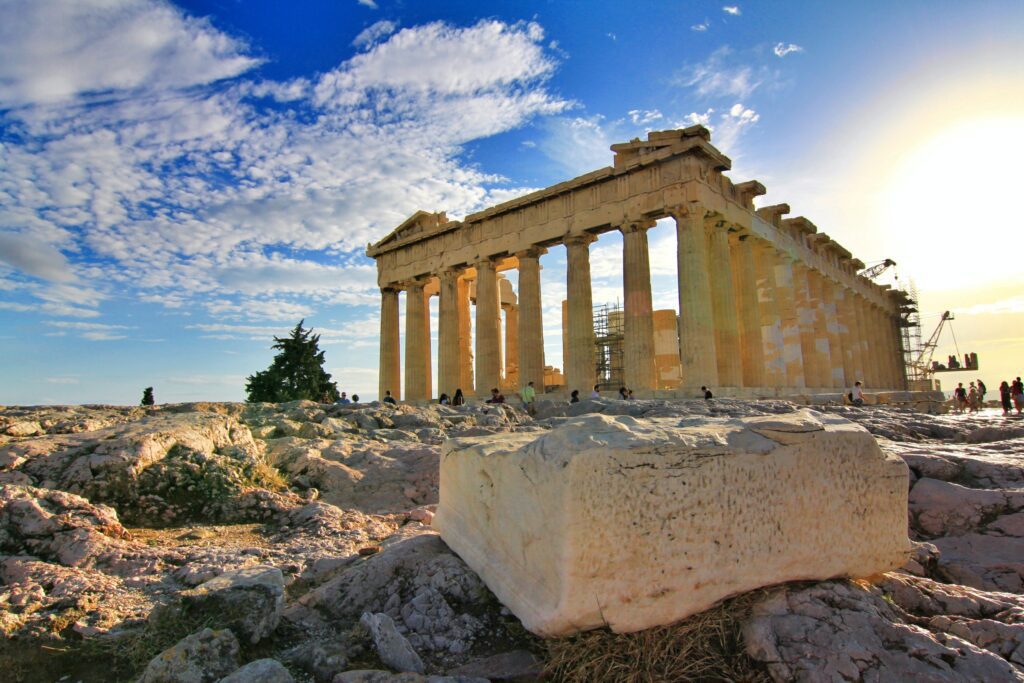
Parthenon is the most imposing structure sitting at the very top of the Acropolis which still evokes a great deal of awe, particularly at a close range. It was built around 440 BC in gratitude to goddess Athena, patron of the city, for her blessings during the war with the Persians. Climbing to the temple, albeit not difficult as such, is a bit challenging in terms of taking care not to slip along the way. Still, the Parthenon is well worth it and is a great spot for taking pictures, given the panoramic views of Athens, the port of Piraeus and the Aegean Sea opening from up there. The construction of the Parthenon was commissioned by Pericles, leader of the ancient Athens metropolis, while Phidias, a renowned master sculptor and mason, supervised its ornamentation. The building itself makes one of the best examples of Doric architecture in Greece; however, the sculptural embellishment is more of an Ionic order. Guides to the temple often use photos with an overlay showing what it looked like complete with roofs and all the other elements. The nearby Acropolis Museum is worth checking out, in this respect, to see the facade marble tiles and other decorations attesting to the grandeur of this site.
The Parthenon remained unchanged until the 5th century AD when it was converted to a church. Under the Turkish rule, it served as a mosque. In 1687, during the siege of the Acropolis by Francesco Morosini, the Parthenon was bombarded and largely destroyed. Another great damage to it came in the early 19th century at the hands of Lord Elgin of Britain, who looted much of the temple’s sculptural decoration and sold it to the British Museum. Despite that, the Parthenon remains one of the most important surviving architectural monuments of Greece and, over the years, has served an inspiration for many public buildings worldwide: parliaments, universities, museums, libraries and more. All the recent renovations of the Parthenon further reveal the timeless beauty of this masterpiece.
Why You Should Visit:
An imposing monument that still evokes a sense of awe when you see it close up. The views of the city from this point (one of the highest) are beautiful, too.
Tips:
Go to the Acropolis early in the morning – otherwise, you may spend 1-2 hours in the line. There are two gates at the Acropolis. Make sure you enter and leave at different gates so you don’t miss anything. You will save money by buying a combination ticket which also covers Odeon of Herodes Atticus, Theater of Dionysus, Temple of Olympian Zeus, and Ancient Agora of Athens.
Erechtheion
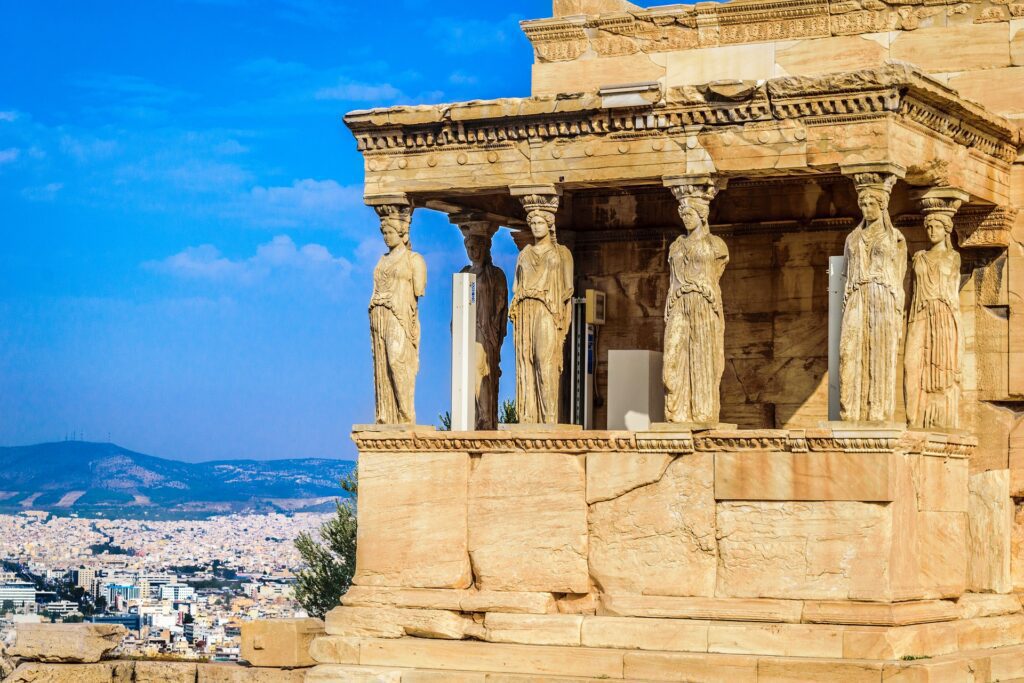
The Erechtheion forms part of the Acropolis and is one of the finest examples of Greek Ionic architecture. It was also the most sacred among temples on the Acropolis due to serving as a sanctuary of the city’s main cults. The temple was dedicated to Athena – goddess of wisdom, Poseidon – the god of sea, and the snake-bodied hero Erechtonius. According to legend, this legendary hero was killed by Poseidon during the battle for the patronage of Athens. Around 400 BC, the leader of Athens, Pericles commissioned sculptor and mason, Phidias to build the structure you may see today. It is made of marble and the friezes were of black limestone. The temple has three main parts: the main temple, the northern and the southern porches. The main temple has two cellae, one dedicated to the Goddess of wisdom, Athena, and the other to the God of sea, Poseidon. It symbolized the reconciliation between the two after their battle for the patronage of Athens. The northern porch has Ionic columns and a Propylon. The most striking feature, however, is the famous porch of maidens. These six massive female figures seem to be supporting the porch roof on their heads. No other temple has such detail for pillars. The maidens are, in fact, plastic copies of the originals now housed in Acropolis Museum. This was done to prevent them from melting further in the caustic climate around Athens. At night the temple’s foundation lights up and illuminates the entire structure on the north side of Acropolis. It’s a beautiful sight to see from a rooftop restaurant or bar within the vicinity.
Why You Should Visit:
Similar to the other temples on Acropolis, this one reflects the ancient Greeks boasting and passion for the powerful gods, glorious heroes, and honorable kings during their time.
At night the temple’s foundation lights up and illuminates the entire structure on the north side of Acropolis. It’s a beautiful sight to see from a rooftop restaurant or bar within the vicinity.
Tip: Try and have a guided tour to experience the full explanations and history of the site. Also, make sure to visit early in the morning as it may get very hot later in the day and carry water as you won’t get anything inside.
Opening Hours: Mon-Sat: 10am-7pm; Sun: 10pm–12am
Temple of Athena Nike
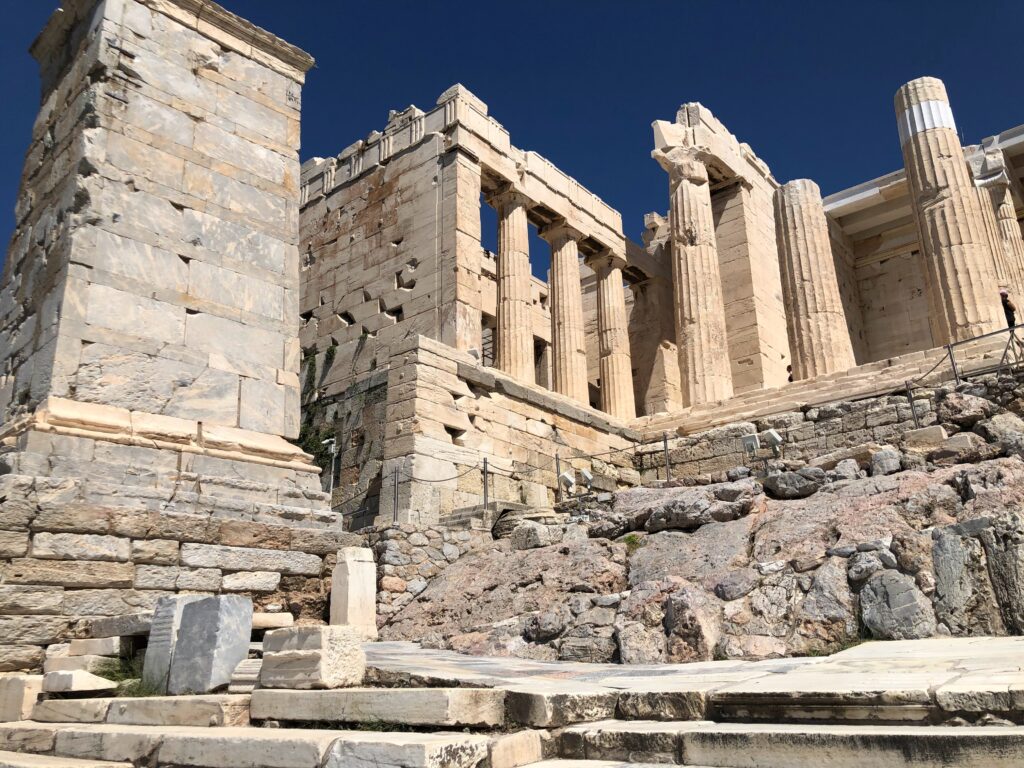
At only 11 feet – or 3.3 metres – in height, this small temple is easy to miss on the Acropolis. It sits atop the rock wall to the right of the Propylaea Gate, and you’ll get a good view of it at the upper right as you enter the Acropolis. Destroyed twice in history, it was successfully rebuilt so you can admire its perfect symmetrical architecture with four Ionic columns at each end. A full-scale restoration was completed in 2010, so it looks very much like it would have looked in 420 BC when Athenians worshiped Athena Nike there. In Greek mythology, Nike was the goddess of speed, strength and victory. Athenians left offerings and prayed that she would help them defeat Sparta in the Peloponnesian War. Unlike other Nike statues which usually had wings, the one at this temple was wingless so that victory could never abandon the city. Looking up, some of the pieces that make the temple’s frieze are still there. Fragments of the frieze are exhibited in the Acropolis Museum and the British Museum.
Tip: Get your multi-ticket pass from somewhere else to skip the queue. Whichever entrance you go in, exit at the other one (i.e. if you enter from the North Entrance, leave by the South) so you see everything.
Opening Hours: Mon: 8am-4pm; Tue, Thu, Sat-Sun: 8am-8pm; Wed, Fri: 8am-1am
Odeon of Herodes Atticus

This stone amphitheater is one of the largest surviving classical Greek theaters in Athens. From ancient times to the present days it has been the venue of musical and theater performances of well known Greek and international performers. The Odeon, also called the Herodeon, was built by the rich Greek aristocrat and Roman senator, Herodes Atticus. It was dedicated as a memorial to his wife in 161 AD. The structure has a stone wall that supports two levels of seats. In classical times, both popular and serious plays were performed at the venue. Today, the marble seating in the gallery has been restored and cushions cover the marble seats for the comfort of spectators. After extensive renovations in 1950, the Odeon has returned to its former glory and is the venue of the summer Athens Festival that features music performances and opera. Acclaimed performers like Maria Callas, Luciano Pavarotti, and Sting have given memorable shows at the venue. International acts continue to appear there, so it’s worth checking the schedule in advance. Watching a concert here on a beautiful night with the moon above you may be the greatest experience you could have. Otherwise, you can just see it as part of a tour of the city.
Why You Should Visit: To admire the majesty of ancient Greek architecture at its peak! Watching a concert here on a beautiful summer night with the moon above you may be the greatest experience you could have. Otherwise, you can just see it as part of a tour of the city.
Tip: International acts are frequent, so it’s worth checking the schedule in advance of travel to Athens. Of course, getting tickets ahead of time is reliant on good weather for a show in this open-air theater.
Opening Hours: Daily: 8am-8pm
Theater of Dionysus
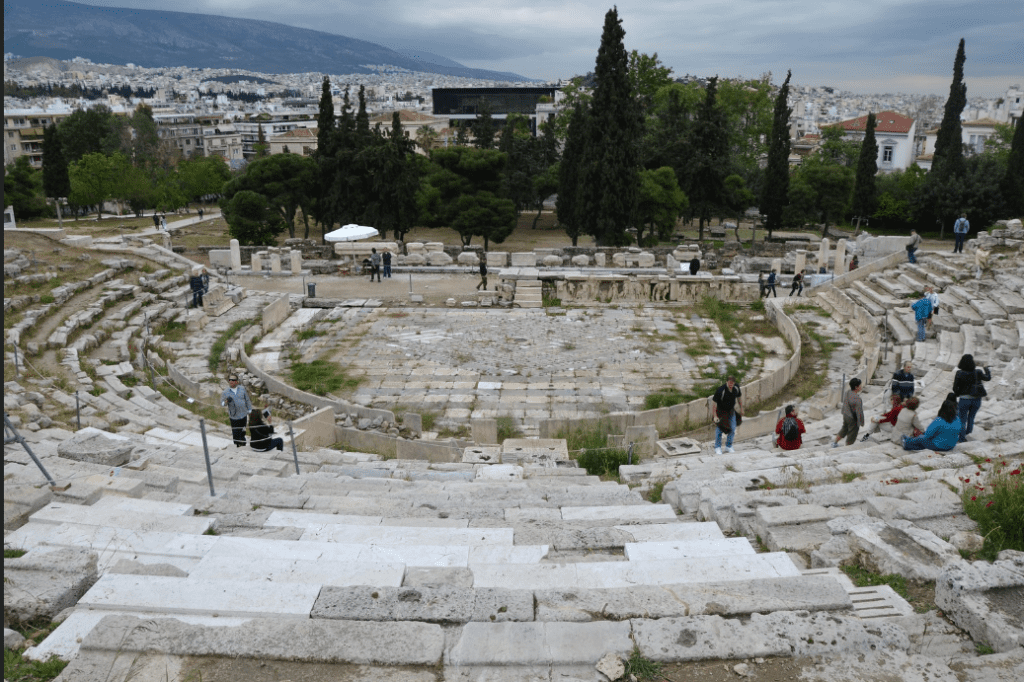
The theater of Dionysus is one of the earliest surviving theaters of classical Greece and is known as the birthplace of European theater. As such, it’s a great opportunity for both theater lovers and kids to get a feel for what ancient theater must have been like. While you can’t climb all over it, access is nicely provided to walk all around the perimeter of the stage and to sit in the seats, which is a great way to make history come alive. Around 500 BC, the theater was erected near the Acropolis for the performance of plays, which were a popular form of entertainment in ancient Greece. The location chosen was near the temple of Dionysus, the God of wine and the patron of drama. Like all the major ancient Greek theaters, the shape of the stage was semicircular and the gallery could seat 25,000 spectators. The theater had fallen into and remained in disrepair until the Roman Emperor Nero ordered its restoration and renovation.
The first drama by classical playwright Thespis from whom the word Thespian was coined, was performed at the venue in 530 BC. Plays of classical Greek dramatists like Sophocles, Aristophanes, Aeschylus, Euripides and Menander were subsequently staged. These well known classical dramatists often competed for a prize awarded for the most popular among plays. Serious Greek tragedies that propounded philosophy in the form of a drama, as well as light popular plays, were also staged at the theater.
Why You Should Visit: Great opportunity for theater lovers, students and kids to get a feel for what ancient theater must have been like. While you cannot climb all over it, access is nicely provided to walk all around the perimeter of the stage and to sit in the seats, which is a great way to make history come alive.
Tip: Access to this site comes either separately or with your Acropolis/Ancient Agora/Temple of Zeus Combo Ticket (well worth the investment).
Opening Hours: Mon: 11am-7:30pm; Tue-Sun: 8am-7:30pm (Apr-Oct); Daily: 8:30am-3pm (Nov-Mar)
Acropolis Museum
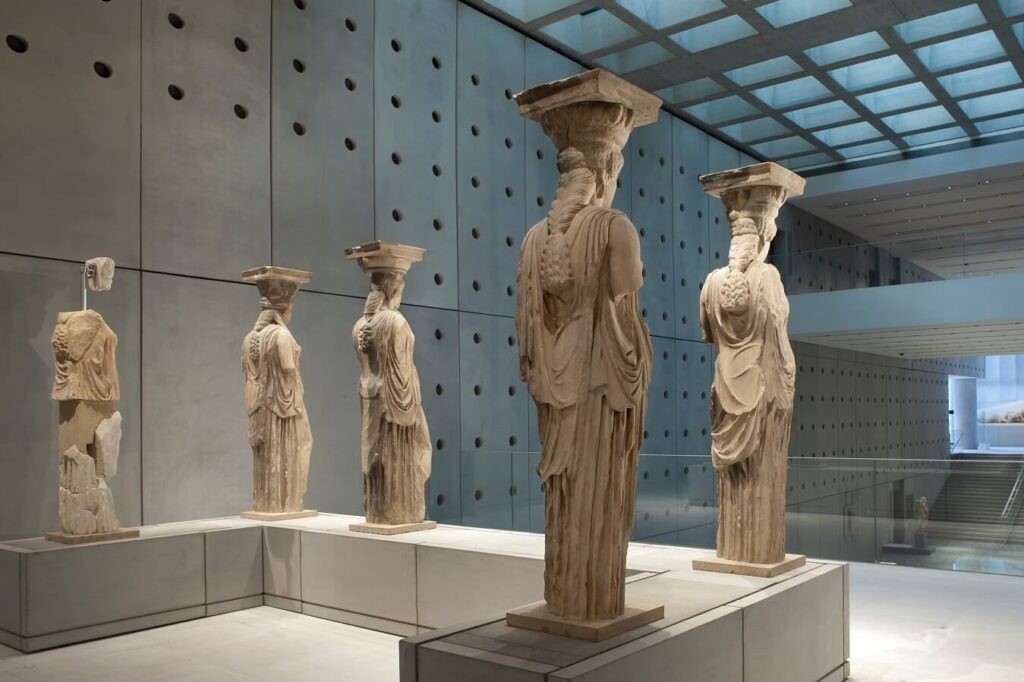
The Acropolis Museum houses all artifacts found in and around the Acropolis in Athens since 2009. It is a four-story modern building located on the southeastern slope of the hill and offers spectacular views of the Acropolis. Collections are displayed on the first three levels while the fourth level holds the museum shop as well as a café serving authentic Greek food.
At the entrance, visitors are greeted by an ancient owl, the sacred bird of Athena, dating back to 500 BC. There is an impressive display of corks, free-standing sculptures of Gods and humans, marble figures, fragmented artifacts and friezes. The outside entryway and walkways are mostly glass floors, so as you walk, you can see the dug-out remains of civilization beneath you. There are also models of the Acropolis and replicas of the Parthenon marbles that are now in the British Museum. The multimedia presentation of the exhibits is interesting and visitors can hire personal guides for a better understanding of the significance of the displayed items. This is an excellent place to get a great introduction to the Acropolis and the birthplace of democracy, with the added advantages of being well organized and air-conditioned.
Why You Should Visit: To get a great introduction to (or great overview of) the Acropolis and the birthplace of democracy, with the advantages of being well organized and air-conditioned.
Tip: Start with the excellent video on the 3rd floor, which ties the museum nicely to the Acropolis (also stunning views of the Acropolis from the windows there), then work your way down (there is an outside terrace on the 2nd floor). There are places on the ground level where you can see through the floor to the active excavation underneath. A guided visit is recommended.
Anafiotika
The tiny scenic district Anafiotika, part of the historic Plaka neighborhood, lies at the foot of the Acropolis hill, seemingly time-forgotten in the shadow of Greece’s most glorious landmark. Poetically referred to as a “breeze of the Aegean” in the heart of Athens, it is perhaps Athens’ loveliest and quirkiest neighborhood. It was built in the 19th century by tradesmen from the island of Anafi who re-created a pocket of home here in a maze of tiny passageways with blue-and-white houses and banks of bougainvillea – all island-style.

– Plaka Steps / Anafiotika Cafe-Restaurant
Recently renovated, the area abounds in small cafes, bars and restaurants scattered on the slopes of the Acropolis within Mnisikleous pedestrian street and nearby. Because of the hilly landscape, this pedestrian street is made in the form of steps lined up with cafes on both sides, with seating arranged creatively (and often compactly, too) along the steps. All this lively commotion resounding with music and happy voices of the folk passing by, eating, lounging around or chatting over a drink contributes to a very unique dining atmosphere observed from the early lunch on through the evening. If you’re looking for a nice place to have dinner and some drinks, the Anafiotika Cafe-Restaurant – located on the narrow Plaka Steps – has a large patio area as well as a rooftop terrace to catch the sunset.
Ancient Agora Museum / Stoa of Attalos
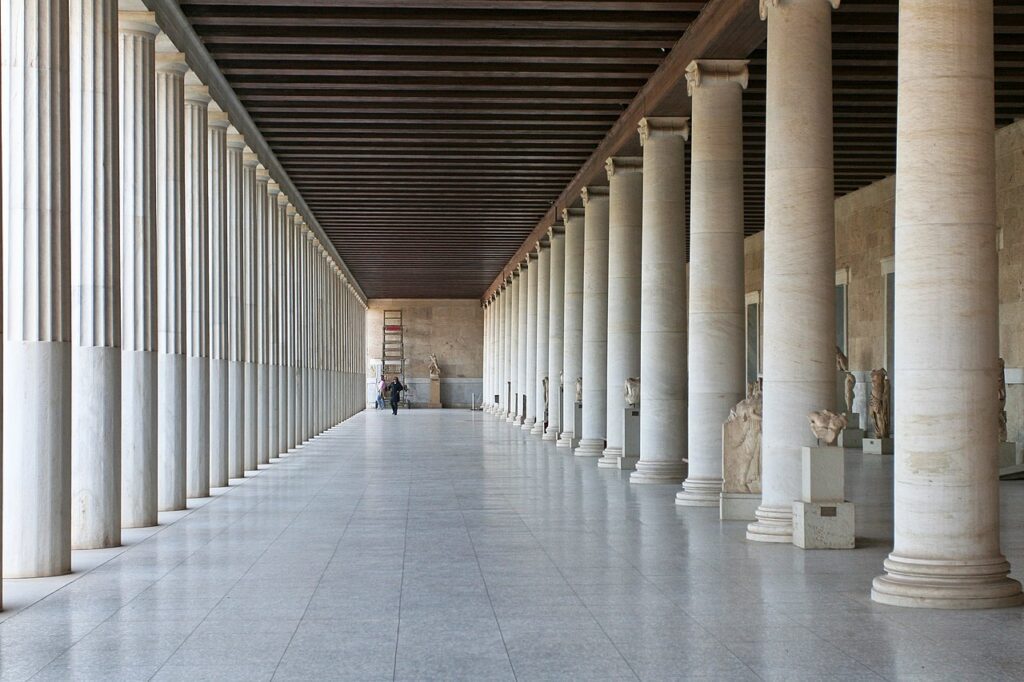
The Ancient Agora Museum is housed in the reconstructed Stoa of Attalos, a most impressive stoa originally built during the 2nd century BC. A stoa is a covered walkway that’s commonly built for public use. This stoa was built by and named after King Attalos II of Pergamon who made it a gift to Athens during his rule. The stoa was more elaborate and larger than earlier buildings in ancient Athens. Its dimensions are 115 meters long by 20 meters wide and it is made of Pentelic marble and limestone. The building skillfully makes use of different architectural orders. The Doric order was used for the exterior colonnade on the ground floor with Ionic for the interior colonnade. It is rather like a modern shopping mall but much more beautiful.
The exhibition in the Museum gallery holds archaeological finds from systematic excavations in the area. The exhibits are dated from the Neolithic to the Post-byzantine and Ottoman periods. And to no one’s surprise, most are connected with Athenian democracy. The museum’s collection includes clay, bronze and glass objects, sculptures, coins and inscriptions from the 7th to the 5th century BC. Notable also is the pottery of the Byzantine period and the Turkish occupation. The museum has no separate fee as entry is always included in the Agora ticket.
Why You Should Visit: Gives you a real sense of the size and grandeur of ancient public buildings; it is rather like a modern shopping mall but much more beautiful.
Tip: The price of entry is included in the Agora ticket. Upper level has a sweeping view of the grounds!
Opening Hours: Daily: 8am-8pm (Apr 13-Oct 31) On Tuesdays, the museum opens at 10am
Ancient Agora of Athens
The ancient Agora of Athens sits below the sacred hill of the Acropolis. This massive site has the ruins of what was once a vast complex. In ancient times, the Agora was the heart of public life in Athens city-state. Over the centuries many administrative buildings, temples, altars, stoas and fountain houses were built around the open square. The square received its final form in the 2nd century A.D. Common citizens would come there to discuss politics and vote for the proposed laws. It was on this square that democracy was born and flourished. In the year 507 B.C., Athenian leader Cleisthenes introduced a system of political reforms that he called demokratia, or “rule by the people.” This system was comprised of three separate institutions: one was the ekklesia, a sovereign governing body that wrote laws and dictated foreign policy; another was the boule, or a council of representatives from the ten Athenian tribes; and finally there was the dikasteria, the popular courts in which citizens argued cases before a group of lottery-selected jurors. Although this Athenian democracy would survive for only two centuries, it was one of ancient Greece’s most enduring contributions to the modern world. Aside for being the city’s political center, the Agora was also a place for religious ceremonies, commercial transactions, theatrical and musical events, and even athletic contests. The site is otherwise well marked and includes the remains of the ancient drainage system. Entry to the museum on site is included in the Agora ticket, and there are some fabulous artifacts that you can see there.

Why You Should Visit: Democracy is one of the most enduring contributions ancient Greeks gifted to the modern world. It all started here, right at this place. The temple is beautiful, and the site is well marked, including the remains of the ancient drainage system.
Tip: The price of entry to the on-site museum is included in the Agora ticket. There are some fabulous artifacts that you can see. Water fountains and restrooms are also close-by.
Opening Hours:
Daily: 8am-8pm (last admission 7:30pm)
Closed: Jan 1, Mar 25, May 1, Easter Sunday, Dec 25/26
Free admission days: Mar 6, Apr 18, May 18, the last weekend of September, Oct 25, every first Sunday from Nov 1-Mar 31
Temple of Hephaestus
The temple dedicated to Hephaestus is the best preserved ancient Greek temple, partly because it was transformed into a Greek Orthodox church from the 7th until the 19th centuries. It is located at the north-west side of the Agora, on top of a hill, and really gives a feel of the true scale of an actual Greek temple, due to the structure being basically intact. In Greek mythology, Hephaestus was the god of fire and metalwork, so he is also described as the god of blacksmiths and artisans. No one but him was able to build the beautiful, indestructible bronze mansions where all the other Olympians lived. The temple’s construction started in 449 BC, and some scholars believe the building has not been completed for some three decades, as funds and workers were redirected towards the Parthenon. According to the “Description of Greece” written by the great Greek traveler Pausanias in the 2nd century AD, the temple housed the bronze statues of Athena and Hephaestos. Trees and shrubs were planted around the temple, creating a small garden. So if you visit, you will have some shady spots as well as great views of other sites from the temple. It is really advisable to get an audio guide as soon as you arrive, as it provides a much better story to the experience.
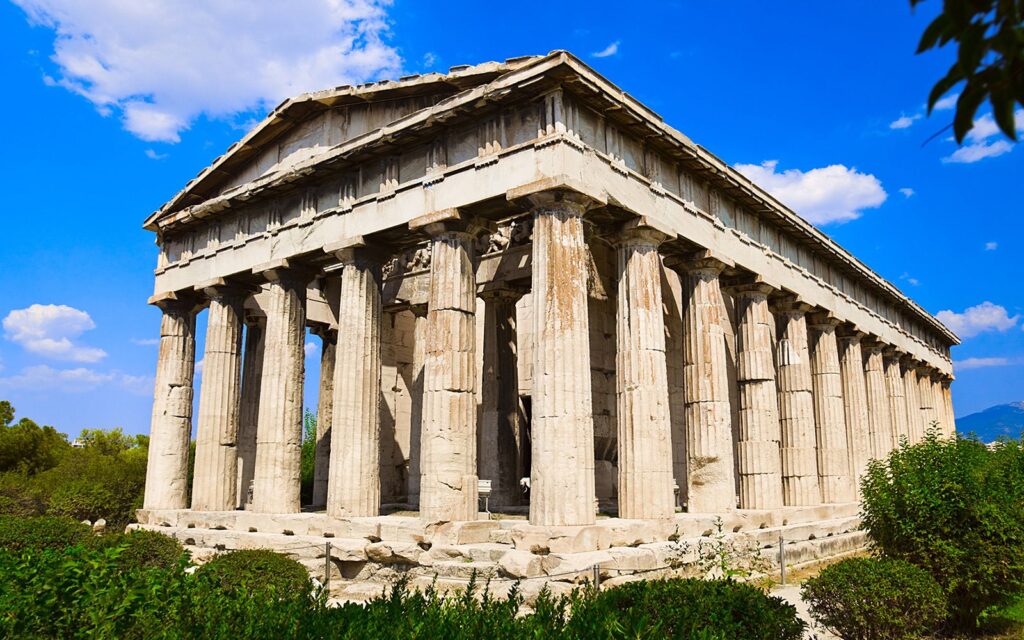
Why You Should Visit: Not as enormous as the remains of the Parthenon or the few ruins of the gigantic temple of the Olympian Zeus but it gives a feel of the true scale of these amazing structures, as the structure is basically intact.
Tip: You can visit this site as part of the Acropolis multi-site ticket, which is highly recommended. It is really advisable to get an audio guide, as this provides a much better story to the experience. While you cannot walk inside the structure, you can walk around it to see the decorative frizes that surround it.
Opening Hours: Daily: 8:30am-6pm (Winter); 8am-8pm (Summer)
Monastiraki Square
A meeting point for locals and tourists alike, Monastiraki square deserves to be visited, if only for a few minutes, to soak up the lively and often festive atmosphere, that is as Greek as it possibly gets, and perhaps try some of the local street snacks, like “koulouri” (a bagel-like roll sprinkled with sesame seeds). The adjacent flea market offers a choice of goods that may rival the Grand Bazaar of Constantinople itself, while the neighboring streets host a cluster of shops, taverns, bistros and coffee/tea houses luring visitors with a chance of a pleasant break. The alley named Mitropoleos (to the east of the metro station) is lined with lively restaurants packed with local Athenians and serving good inexpensive food. At the entrance to Mitropoleos Square, is the famous kebab joint SAVVAS (9am–4am), specializing in gyros, kebab, lahmacun, and pastrami appetizers. Dishes are huge and a great value for money; plus, you get a very nice view of the Acropolis from the rooftop terrace.

CAFE AVISSINIA (Tue-Sun: 11am–1am), located in the eponymous Avissinia Square, is the only establishment around Monastiraki where antiques are not for sale but form part of the interior. More than just an eatery or a watering hole, this tavern is a manifestation of Greek philosophy and culture. Opened back in 1986 as a small tea house, today Avissinia is a classic haunt offering a choice of Greek delicacies, moussaka, grilled calamari, baked sardines, and most notably, live music to delight the multiple clientele! There are three seating areas one of which has a fabulous view of the Acropolis.
Pandrossou Street Market
The busy market on the narrow Pandrossou Street is a cluster of nearly one hundred shops. Vendors offer almost anything, from postcards to a range of souvenirs and local memorabilia. The choice is enormous and the quality of items on sale is generally good, including traditional and locally-made stuff. Alongside regular souvenir stalls, there is a fairly good choice of antiques and other valuable items. Plus, the flea market held on Sundays is a sight to behold. So if you plan to bring home some locally made souvenirs or Greek specialty products, this is definitely a good place to visit. Just stay aware of the occasional pickpocket, and you’ll be fine.

Tip: The flea market here on Sundays is a particularly great time to visit. The range of antiques, junk and sometimes, valuable items, are strewn all across tables, over cars and even along the street.
Metropolitan Cathedral

This cathedral church, more popularly known as the “Metropolis”, has recently been cleaned, restored and reopened to visitors. The interior decoration, with elaborate icons, decorations, and detailed murals, is beautiful and a great example of Greek Orthodox faith. Construction of the church began on Christmas Day, 1842, with the laying of the cornerstone by King Otto and Queen Amalia of Greece. Workers used marble from 72 demolished churches to build the structure’s immense walls. Three architects and 20 years later, it was complete. Inside are the tombs of two saints killed by the Ottoman Turks during the Ottoman period: Saint Philothei and Patriarch Gregory V. In the Square in front of the Cathedral stand two statues of the last Byzantine Emperor, killed defending Constantinople against the Ottomans, as well as of the World War II Archbishop who worked to save Athens’ Jews from the Nazi persecution. The square itself is much quieter than Syntagma Square and is a great spot to escape the bustle while having a drink in one of the cafes.
Opening Hours: Daily 6:30am-7pm
Ermou Street
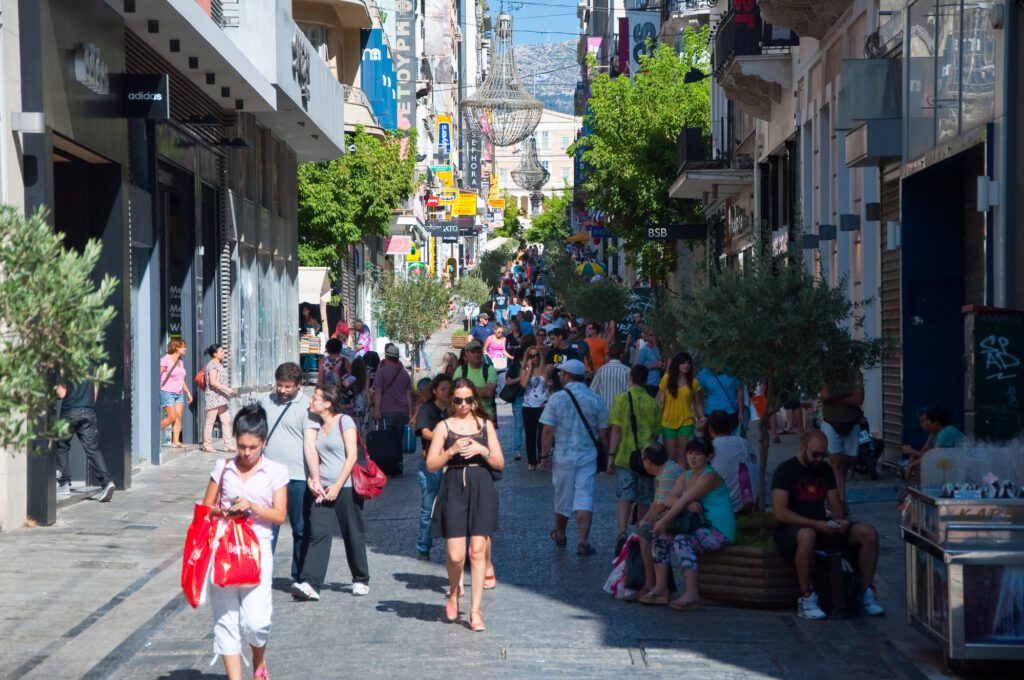
Ermou Street is a one-and-a-half-kilometer-long road in central Athens, right off Syntagma Square. It is the most expensive shopping street in Athens and one of the most expensive in Europe. The shops are selling everything from high-end clothing to trinkets, leather goods, embroidery, and higher quality jewelry – but you can also find a few great local grocery stores or have a rest for a coffee or tea at the many cafes lining the street.
Tip: Please be aware that the majority of the shops are actually closed on a Sunday.
Syntagma Square
Syntagma Square is a large public square located in front of the 19th-century Royal Palace, that houses the Greek Parliament since 1935. The square is named after the Constitution that Otto, the first King of Greece, was obliged to grant to the Greek people, after a popular and military uprising in 1843. The square is now a bustling destination located near many major tourist attractions and connected by many busy roads. It is also a major transportation hub where trams, buses, and the subway take people to several important destinations in and around Athens. At the same time, the square remains an important venue for public meetings and political demonstrations. Syntagma Square is laid in two levels, with the Eastern part being higher than the Western. There is a fountain at its center and several benches where visitors relax or use free public Wi-Fi internet. There are two green areas with pine and orange trees as well as cafes that offer refreshments. The city has recently renovated the square with white marble and new lamp posts. The fountain and benches around it have also been restored. You’ll probably find yourself in this square at some point as it’s so central and is also one of the most common meeting points.
Why You Should Visit: Undoubtedly the most important square of modern Athens from both a historical and social point of view, it sits at the epicentre of commercial activity and Greek politics. You will probably find yourself in this square at some point as it’s so central, connects many places and is also one of the most common meeting points.
Tip: At the bottom of the square is the beginning of Ermou Street, the main shopping street of Athens filled with different stores and a flea market to browse around.
Hellenic Parliament House
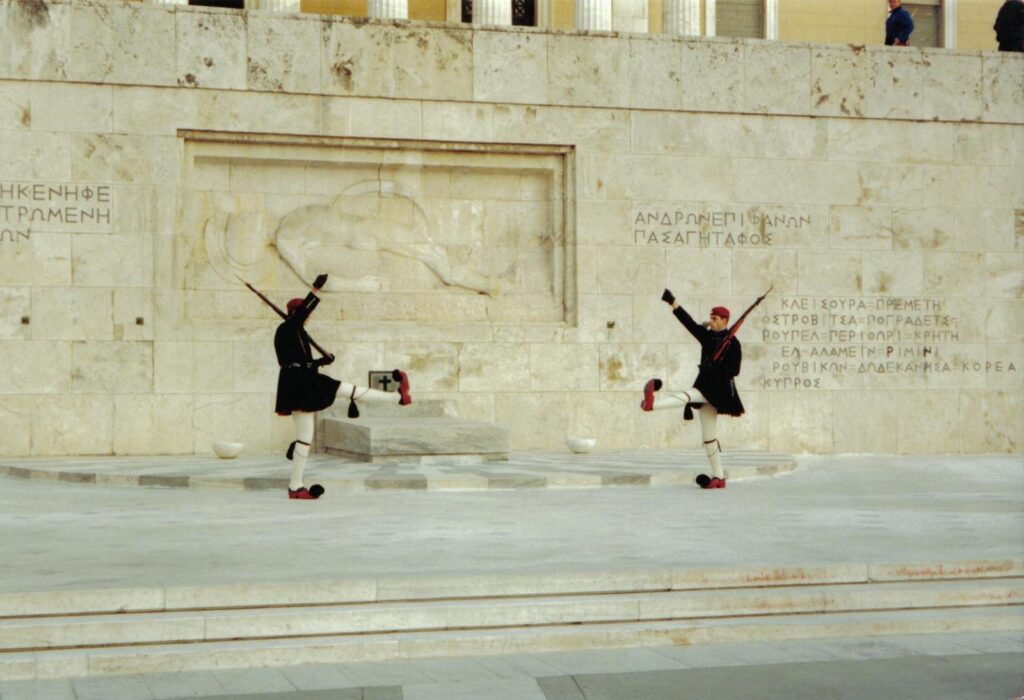
The building that houses the Hellenic Parliament was once the old palace of the Greek Royal Family. After being damaged by a fire at the turn of the 20th century, the Royal Family moved to the new palace which is now the Greek Presidential Mansion. This neoclassical building was originally completed in 1840 based on the plans of Bavarian architect, Friedrich von Gärtner. It served as the official residence of Otto, the first King to rule Greece after the end of the Turkish occupation. Otto’s father King Ludwig of Bavaria financed the building’s construction, which was later remodeled to make it a suitable parliament house. It became the building of the National Assembly of Greece in 1935. The building now houses the offices of the President of the National Assembly, along with archives and other services. To the front is the tomb of the Unknown Soldier, guarded by an elite regiment called the Evzones. The changing of guard by the Evzones takes place on the hour and is a popular tourist attraction. The traditional outfit and the ceremony are something not to miss!
Tip:
Keep in mind that you cannot step on the marble stairs and only enter one side of the palace that shows the beautiful marble walls/floors as well as the artistic ceiling of a palace. No tour guide needed.










